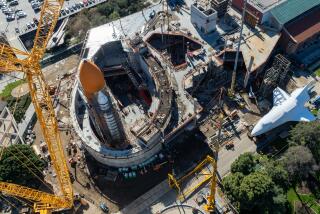Shuttle Lab to Give Best Look Yet at Violent Cosmic Activity : Device Peering Into Hearts of Galaxies
- Share via
HOUSTON — The space shuttle Discovery left a compact, self-contained laboratory in orbit Thursday to give astronomers their best look yet at the dynamic, violent activity at the center of galactic clusters.
The Discovery will drift about 100 miles from the device, called Spartan 1, and then return to retrieve it Saturday morning.
For the record:
12:00 a.m. June 22, 1985 For the Record
Los Angeles Times Saturday June 22, 1985 Home Edition Part 1 Page 3 Column 1 National Desk 2 inches; 58 words Type of Material: Correction
Due to an editing error, a story in Friday’s Times incorrectly stated that a device placed in orbit by the space shuttle Discovery will give astronomers their best look yet at galactic centers. The device, called Spartan, should be of major importance to X-ray astronomers, but it is not the only type of instrument used to study those areas of the universe. The term X-ray was dropped from the lead of the story.
During that 45-hour period, Spartan will maneuver itself to point its instruments at the hot gases at the center of the Perseus cluster of galaxies. It will also study the center of our own Milky Way galaxy, thought by many scientists to be a black hole, an extremely dense object with gravity forces so great that even light cannot escape.
Galactic dust obscures the center of our galaxy, but the X-rays emitted by the hot gases in the center should penetrate that dust and reach instruments aboard Spartan, possibly disclosing more about the center, project scientist Ray Cruddace said.
Exploratory Mission
“Our mission is very much an exploratory one,” he said.
Astronomers have used X-ray devices for the last quarter-century to study the heavens, but, because X-rays are filtered by the Earth’s atmosphere, most of that research has been limited to small “sounding rockets” that boosted the instruments above the atmosphere for five or six minutes.
Spartan will extend that period to nearly two full days, providing an opportunity for prolonged observation.
The device, which is scheduled to be flown several times, cost about $5 million--relatively inexpensive by Space Age standards--and was designed to be as simple as possible, Cruddace said.
It uses batteries instead of complex solar collectors, and all of the data it acquires will be stored aboard Spartan for later analysis. Scientists will probably study the data for about six months before drawing any conclusions, Cruddace said.
Second Chance Today
The successful deployment of Spartan went smoothly for the crew, which was slated to get a second chance today to complete the first known “Star Wars” missile defense experiment aboard the shuttle. The Discovery will attempt to position itself so that a mirror mounted in a port window near the nose of the craft will reflect a low-power laser beam from the Hawaiian island of Maui.
That experiment failed Wednesday when the wrong information was fed into the Discovery’s computers, causing the shuttle to pass over Maui with the window facing the sky instead of the Earth. The National Aeronautics and Space Administration decided to try again today instead of waiting for a previously scheduled backup opportunity Saturday.
The Discovery is scheduled to land at Edwards Air Force Base on Monday at 6:14 a.m.
The ship’s crew includes five Americans: Daniel C. Brandenstein, 42, the commander; John O. Creighton, 42, the pilot; and mission specialists Steven R. Nagel, 38, John M. Fabian, 46, and Shannon W. Lucid, 42. Patrick Baudry, 39, a French astronaut, and Prince Sultan ibn Salman al Saud, 28, of Saudi Arabia, also are aboard.






